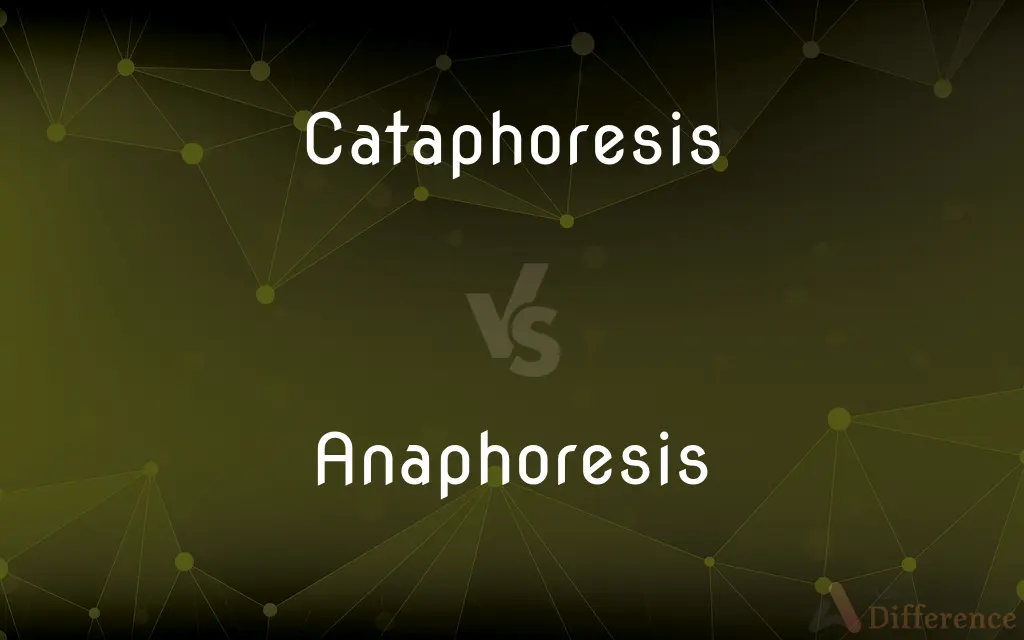Cataphoresis vs. Anaphoresis — What's the Difference?
By Tayyaba Rehman — Updated on November 3, 2023
Cataphoresis involves particles moving toward a cathode in a fluid medium, while anaphoresis refers to the movement toward an anode.

Difference Between Cataphoresis and Anaphoresis
Table of Contents
ADVERTISEMENT
Key Differences
Cataphoresis is a process where negatively charged particles move towards a positively charged electrode, known as a cathode, within a fluid under the influence of an electric field. Anaphoresis, on the contrary, involves positively charged particles migrating towards a negatively charged electrode, the anode.
In cataphoresis, the motion of particles towards the cathode is facilitated by the electrical potential, often used in industrial coatings. Anaphoresis often describes the movement in electrophoresis where particles are driven by electrical potential across a medium towards the anode.
The term cataphoresis can also be applied in medicine, where it is used for therapeutic and drug delivery purposes, by moving substances across the skin. Meanwhile, anaphoresis is not commonly referenced in medical contexts but is a critical part of the separation processes in chemistry and biology.
One could see cataphoresis as a specific type of electrophoresis. Anaphoresis, although less commonly used, is a term that complements cataphoresis in the description of particle movements in an electric field, helping to provide a full picture of the directional movement possibilities.
While cataphoresis is mostly associated with coatings and medicinal applications, the principle behind it serves various industrial processes. Anaphoresis is typically discussed in analytical and preparative processes, particularly in biochemistry for the separation of molecules.
ADVERTISEMENT
Comparison Chart
Charge of Particles
Negatively charged
Positively charged
Direction
Toward the cathode (positive electrode)
Toward the anode (negative electrode)
Common Usage
Industrial coatings, medicine
Biochemistry, analytical chemistry
Electric Field Role
Drives particles to a positive charge
Drives particles to a negative charge
Contextual Use
More common in industrial applications
More common in scientific research
Compare with Definitions
Cataphoresis
Cataphoresis involves the application of DC current to drive substances across the skin.
The medication was administered through cataphoresis for deeper skin penetration.
Anaphoresis
Anaphoresis is used in biochemistry for the separation of molecules by their charge.
Anaphoresis allowed for the precise isolation of the desired cellular components.
Cataphoresis
Cataphoresis is the movement of particles toward a cathode in a fluid medium.
Cataphoresis was used to apply the paint evenly across the metal surface.
Anaphoresis
Anaphoresis is the migration of particles toward an anode in an electrolyte solution.
Anaphoresis was observed during the electrophoretic experiment in the lab.
Cataphoresis
It is a technique for coating objects by attracting negatively charged particles to a surface.
The cataphoresis process resulted in a durable and even protective layer on the car parts.
Anaphoresis
In anaphoresis, particles are drawn to a negative electrode due to electrical potential.
The anaphoresis process ensured the collection of ions at the anode.
Cataphoresis
Cataphoresis can be a medical procedure for ionic drug transport.
The patient underwent cataphoresis for targeted drug delivery.
Anaphoresis
It can describe the electrokinetic phenomenon in an opposite manner to cataphoresis.
Contrary to cataphoresis, anaphoresis was responsible for the attraction of cations in the solution.
Cataphoresis
In cataphoresis, particles migrate in response to an electric field towards a positive electrode.
Cataphoresis was critical in the experiment to ensure the particles adhered to the substrate.
Anaphoresis
It refers to the movement of positively charged colloids under the influence of an electric field.
Scientists used anaphoresis to separate various proteins for analysis.
Cataphoresis
See electrophoresis.
Anaphoresis
(physics) The movement of electrically charged particles towards an anode.
Cataphoresis
Electrophoresis
Anaphoresis
(medicine) A reduction in the activity of the sweat glands.
Cataphoresis
The motion of charged particles in a colloid under the influence of an electric field; particles with a positive charge go to the cathode and negative to the anode
Common Curiosities
In which fields is anaphoresis used?
Anaphoresis is mainly used in biochemistry and analytical chemistry.
What are the applications of cataphoresis?
Applications include industrial painting, coating processes, and medicinal treatments.
How does anaphoresis work?
Anaphoresis works by moving positively charged particles toward an anode.
Are cataphoresis and anaphoresis types of electrophoresis?
Yes, they are specific directional types of electrophoresis.
What is the outcome of cataphoresis in industrial uses?
It results in even and durable coatings on various materials.
Does anaphoresis have a role in medicine?
Anaphoresis itself is not typically referenced in medicine.
Can anaphoresis separate DNA fragments?
Yes, it is used in gel electrophoresis for DNA fragment separation.
Is cataphoresis environmentally friendly?
Cataphoresis can be environmentally friendly compared to other coating methods.
Do both cataphoresis and anaphoresis require an electric field?
Yes, both require an electric field to drive particle movement.
What is cataphoresis?
Cataphoresis is the migration of negatively charged particles toward a cathode.
Can cataphoresis be used for drug delivery?
Yes, it can be used to deliver drugs across the skin by ionic movement.
What types of particles move in anaphoresis?
Positively charged particles, or cations, move in anaphoresis.
What kind of power source is used in cataphoresis?
A direct current (DC) power source is used in cataphoresis.
Is cataphoresis a common medical procedure?
It's not common but is used in certain transdermal therapeutic systems.
What safety precautions are necessary for anaphoresis?
Proper lab safety, including gloves and goggles, is essential when performing anaphoresis.
Share Your Discovery

Previous Comparison
Equality vs. Fairness
Next Comparison
Conformity vs. ObedienceAuthor Spotlight
Written by
Tayyaba RehmanTayyaba Rehman is a distinguished writer, currently serving as a primary contributor to askdifference.com. As a researcher in semantics and etymology, Tayyaba's passion for the complexity of languages and their distinctions has found a perfect home on the platform. Tayyaba delves into the intricacies of language, distinguishing between commonly confused words and phrases, thereby providing clarity for readers worldwide.














































